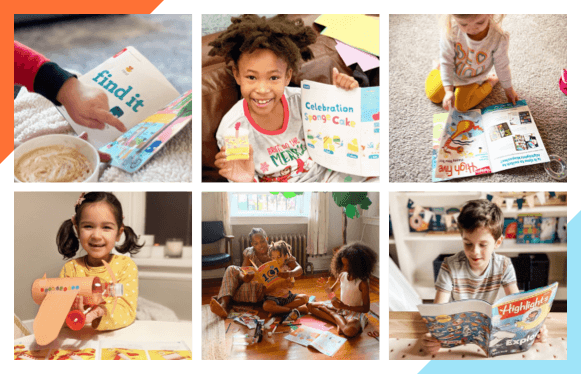15 Family Games to Play Outside
By: Highlights Editorial
What better way to spend a summer afternoon than playing outside with your kids? We've compiled 15 family-friendly games for you to try. We're sure you'll find a few faves your family will want to play again and again.
Start your summer fun with the 15 games below!
1. S-P-U-D
Best for: 5 to 6 year olds
Number of players: 4 or more, with no limit
What you need: A large, inflated soft ball
Where to play: An open field or large backyard
How to play: Assign players a number within a range, such as 1–10. Choose a player to be “it.” The player who is “it” holds the ball while everyone else forms a circle around them. “It” throws the ball straight up in the air while shouting one of the assigned numbers. The player with that number catches the ball. Everyone else runs as far from the circle as possible. The player with the ball then yells “Spud!” and all others freeze where they are. The player tosses the ball at any player. If the player tags someone with the ball, that person (who was unable to escape) gets a letter in the word spud; if the ball misses that player, the “it” gets a letter. The player with the letter throws the ball in the next round. Once a player gets all four letters S-P-U-D, they’re out of the game.
Game is over when: Last one standing!
Good to know: You can’t run away from the ball that’s headed in your direction. Also, you can bend the rules for younger children, letting them take three steps before throwing the ball.
2. Mother May I?
Best for: All ages (Young ones find it easy to follow the rules, and older kids find it fun to get creative with requests)
Number of players: At least 3
What you need: Manners (just kidding)
Where to play: A driveway, sidewalk or a large pathway.
How to play: One child plays “Mother.” The others are “children,” positioned about 20 feet from where “Mother” is standing. “Mother” turns away from the other players and chooses a child at random. The child then says, “Mother May I _________?”, and asks permission to approach the mother, using predictable or unusual maneuvers to move forward. Examples include “…take 3 giant steps forward,” or “…do a cartwheel,” or “hop like a frog 5 times.” The mother, in turn, says either, “Yes, you may” or “No, you may not, but…” and suggests an alternate move.
Game is over when: The first child reaches “Mother.”
Good to Know: The more creative the moves, the more fun the game. It’s also called Captain May I?
3. Hot Potato
Best for: A low-energy moment
Number of players: 4 or more
What you need: small beanbag, music
Where to play: Grassy area
How to play: Children sit in a circle and toss the beanbag clockwise to music. An adult—or a child who is not in the circle—randomly pauses the music. The player who is holding the beanbag—the “hot potato”—when the music stops, is out. The game continues with the remaining players.
Game is over when: One child is left.
Good to know: Hot potato can be played with other objects, like a tennis ball or an actual potato. No music? Just have someone yell “Hot potato!” instead.
4. Hopscotch
Best for: Preschoolers
Number of players: 2 or more
What you need: Chalk, flat stones for markers
Where to play: On sidewalk, patio or driveway
How to play: Draw a traditional hopscotch course—alternating single and double squares—and number them 1 to 10. Player 1 tosses a stone into the first square—without landing on the lines. Then they hop from square to square, bypassing the one with the stone. The player hops on one foot in the single squares, and two feet in the doubles, with one foot in each square. When they reach the end of the course, they hop back. If the player maintains their balance, doesn’t step on any lines and completes a successful run, they toss a stone into the second box and so on. If the stone hits a line or Player 1 falters, Player 2 gets a turn.
Game is over when: A player completes the course.
Good to know: No pavement? Draw the course in dirt or sand with a stick.
5. Limbo
Best for: Preschoolers and up, but toddlers can join the fun too by running or ducking instead of bending backwards
Number of players: 4 or more
What you need: A long stick or broomstick
Where to play: Any outdoor space
How to play: Two players hold the limbo stick about 4 feet off the ground. The remaining players approach the stick one at a time, bending backward to pass under the stick, without coming in contact with it. The stick is lowered about 6 inches in every round. Players who touch the stick are out.
Game is over when: Only one player can pass under the stick without touching it.
Good to know: For a twist, players can walk backwards or sideways under the stick.
6. H-O-R-S-E
Best for: Competitive kids’ hoop skills and imagination
Number of players: 2 or more
What you need: Basketball, a flat surface and a basketball hoop or alternative (e.g., a sturdy laundry basket)
Where to play: Your driveway (or a public court)
How to play: Kids take turns matching the exact shot and location of the previous player. If Player 1 creates (and sinks) a shot the opponent can’t replicate, Player 1 wins the round and the opponent (Player 2) earns the letter “H.” If Player 1 misses their own shot, Player 2 can attempt any shot from any location, and if they sink that shot, Player 1 must duplicate it. The game continues until one player accumulates all the letters H-O-R-S-E.
Game is over when: One player is left standing.
Good to know: You can flip a coin to determine the starting player.
7. Double Dutch
Best for: Skilled jumpers with timing and coordination
Number of players: 3 (2 to hold the ropes, 1 to jump)
What you need: Two 16” double-dutch jump ropes
Where to play: A driveway, large patio, blacktop or another flat surface
How to play: Two children stand face-to-face, several feet apart, holding one end of a jump rope in each hand. They start by turning the ropes in opposite directions as a third child jumps in. Kids can decide beforehand whether to jump for fun, add a speed round (the most jumps per minute) or go for a freestyle round with tricks. Kids take turns once the jumper misses a jump.
Game is over when: One player becomes the first to reach a pre-set number of points, based on the number of jumps or tricks achieved. (Or kids can quit when fatigue sets in.)
Good to know: Adding rhymes helps keep the rhythm going. Try this motivator to start:
Cinderella, dressed in yellow
Went upstairs to kiss her fellow
Made a mistake
And kissed a snake
How many doctors
Did it take?
1, 2, 3, 4, 5 . . .
8. Kick the Can
Best for: Competitive older kids
Number of players: 4 to 6
What you need: An empty metal soda, soup or paint can
Where to play: A large outdoor space with places to hide
How to play: The kid who’s “it” places a can in an obstruction-free location, closes their eyes and counts to a pre-designated number while other players hide. The “it” then seeks the other players. If they spot a kid who’s hiding, they call out that name and the two players race back to the can. If the “it” gets there first, the captured player goes to jail. If the captured player prevails, they kick the can, find a new place to hide and the “it” resets the can. (A kicked can also frees previously captured players.)
Game is over when: Only one person is left hiding.
Good to know: Jailed players can stand off to the side of the play area, on a porch or at some other visible location.
9. Foursquare
Best for: Kids with balance and coordination
Number of players: 4 or more
What you need: A rubber playground ball, chalk (to make the court)
Where to play: A blacktop or another flat surface
How to play: Kids draw a large square, divide it in quarters and number the boxes from 1 to 4, representing a king, queen, jack and ace. One player stands in each quadrant. The player in quadrant one (the king) serves the ball to another player. The receiver then hits the ball (after a single bounce) to another player of their choosing. If the ball heads out of bounds or a player misses the ball, the at-fault player is out. Players advance to higher-ranked squares, in what is, essentially, a knockout competition. New players take a spot on the lowest-ranking square.
Game is over when: One kid is the supreme ruler, but play can continue indefinitely.
Good to know: The king can customize the game by adding rules, such as single-handed or one-legged hits.
10. Tug of War
Best for: Teamwork, and kids with a competitive edge
Number of players: An even number for two balanced teams (an extra kid can serve as judge)
What you need: A long, sturdy rope, tape, chalk or flour
Where to play: A large grassy field or lawn
How to play: In teams, kids divide the field in two (using flour or chalk) and mark the center of the rope with tape or chalk. Each team holds one end of the rope; players pull to drag the opposing team over the line to their side.
Game is over when: Most of the rope crosses over the divider.
Good to know: Put the strongest kids at the end of the line.
11. Ghost in the Graveyard
Best for: Responsible tweens who respect curfews
Number of players: Unlimited
What you need: Moonlight and places to hide
Where to play: On a field or around the neighborhood within a set number of blocks
How to play: The “ghost” hides while the remaining players stay at home base and count: 1 o’clock, 2 o’clock, 3 o’clock, 4 o’clock…up until midnight. At midnight, ghost hunters spread out and start their search. The first to spot the ghost yells, “Ghost in the Graveyard!” The ghost bolts out of hiding to chase the other players. Players race to home base before the ghost tags them. The tagged ghost hunter is the ghost for the next round.
Game is over: At curfew.
Good to know: The ghost can emerge from hiding to tag another player before they are seen.
12. Pool Noodle Hockey
Best for: Ages 3 to 6
Number of players: 2 or more, in even numbers
What you need: 1 pool noodle for each child, and 1 balloon or beach ball to bat around
Where to play: A backyard or open field
How to play: Create 2 teams. If you have more than 2 players, appoint goalies for each team. They guard the goals (use rope, cones or planters to mark the goal lines). The object of the game is to hit the ball into the field goals to score points. Reckless taps, body bashing and sword fights are not permitted. As a group, decide on how long the game should last and set a timer.
Game is over when: One team has the highest score.
Good to know: Keep backup balloons handy.
13. Ladder Ball
Best for: Ages 5 to 6
Number of players: 2 or more, in even numbers if playing on teams
What you need: A ladder from your garage, beanbags, pen and paper
Where to play: A yard or open area
How to play: Assign each rung on the ladder a point value, starting at 10 and increasing in increments of 10 points until you reach the top of the ladder. Tape a piece of paper with the number representing the point value to each rung. Player 1 stands a few feet away from the ladder. They toss beanbags between the rungs on the ladder and their score is tallied. Game continues with remaining players. As a group, decide on how long the game should last and set a timer.
Game is over when: When the time limit is reached, the player or team with the highest score wins.
Good to know: When playing with a group, appoint a score keeper.
14. Glow-Stick Balloonacy
Best for: Ages 3 and up
Number of players: 2 or more
What you need: 8 glow sticks, and 1 big balloon (keep extra balloons on hand, just in case)
Where to play: A yard or park with a tree
How to play: Connect 7 glow sticks to form a large circle, about the size of a Hula Hoop. Slide another glow stick into a balloon and blow it up. Hang the hoop from a tree branch. Place one player on each side of the hoop. Players volley the balloon through the hoop. If a player misses the shot, the other side gets a point. Set a reasonable time limit for the age of the players who are playing.
Game is over when: When the time limit is reached, the player with the highest score wins.
Good to know: If there are more than 2 players, the winner plays the waiting players in the following rounds.
15. Rock ’n’ Tic-Tac-Toe
Best for: Ages 4 and up
Number of players: 2
What you need: Chalk, 10 palm-sized rocks you can find in your yard and 1 black indelible ink pen to mark the rocks
Where to play: Patio, sidewalk or driveway
How to play: Mark 5 rocks with an “X” and 5 with an “O” to make the game pieces—or paint the rocks different colors (one color for Player 1, and the other color for Player 2). Then use chalk to make a 3 x 3 grid of squares. Players take turns placing rocks in the squares.
Game is over when: The first player places three of their rocks in a row in any direction—or tic-tac-toe.
Good to know: Have a family tournament!
When it comes to summer activities for kids, you can always find fun at Highlights. Summer crafts, science project ideas, summer art projects and more things to do this summer…how will YOU summer this year?









